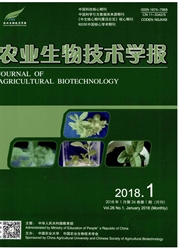

 中文摘要:
中文摘要:
蔗糖磷酸合成酶(SPS,EC2.4.1.14)是植物糖分积累的关键酶基因,在甘蔗中其家族成员SPSⅢ在成熟蔗茎中表达量高,是禾本科作物的特异成员。本研究应用酵母在甘蔗中单杂交系统,筛选SPSⅢ 5’侧翼-1410- -1181bp的光响应元件ATCT—motif和分生组织特异性元件CAT—box的调控序列,获得了54个含有cDNA片段的文库质粒,测序分析显示,14个cDNA序列为非重复性。NCBI的Blast同源性结果显示,除E1.3、E9—1和E0.3外,其余克隆都与甘蔗(Saecharum spp.)近缘物种的蛋白有很高的同源性,达到90%以上。通过SMART和SBASE,对推演的氨基酸序列进行蛋白质功能结构域预测与分析,显示编号为E0—3、E2—3、F2.1、F4—2和G8—2的5个克隆对应的氨基酸序列具有转录因子特征结构域。研究结果为分离调控SPSⅢ基因表达的转录因子提供了候选基因。
 英文摘要:
英文摘要:
Sucrose phosphate synthase (SPS, EC 2.4.1.14) is a key enzyme for sucrose metabolism in plant. In sugarcane, at least 5 genes were classified into 4 subfamilies of SPS. Of the 5 SPS genes, SPSⅢ has high-level expression in the mature stem tissue of sugarcane, which is considered to be a Poaceae-specific member. Therefore, the study of binding protein genes of Cis-element in promoter region of SPS Ili would provide initial insight for regulation of sucrose metabolism. In this study, to specific analyze the function of ATCT-motif and CAT-box from SPS Ⅲ in sugarcane (Saccharum spp.) for potential Cis-element of light response ATCT-motif and meristem-specific, the fragment containing ATCT-motif and CAT-box from SPS Ⅲ promoter region (from -1 320 to-1 210 bp) were cloned into T-vector, then, yeast one-hybrid bait vector pAbAi-SPS Ⅲ-A C were constructed and transformed to yeast. Subsequently, the ds-cDNA from mature leave of sugarcane were transformed to the yeast one-hybrid bait vector for constructing the Yeast One-hybrid Library System, and the insert sizes of the library were identified to be ranged from 0.25 kb to 1.5 kb. Fifty four positive clones of the candidate binding protein cDNA sequences were obtained from the Yeast One-hybrid Library, of them, 14 sequences were observed to be unique based on sequencing. Blast analysis showed that, besides E 1-3, E9-1, and E0-3, the other 11 cDNA sequences had high homology to the close relatives of sugarcane with identities above 90%. E0-3 was found no Blast hit in the NCBI, which could be undiscovered gene or sugarcane specific gene. Furthermore, the potential Cis-element sequences were analyzed through SMART and SBASE. The results showed that five of the sequences, E0-3, E2-3, F2-1, F4-2 and G8-2, contained regulated motif domain. E2-3 was assumed to be a light-regulated element for SPS Ⅲ -A C due to the photo morphogenesis relative domain transcript presented in the corresponding amino acid sequence. BURP domain was proved to take part in the regu
 同期刊论文项目
同期刊论文项目
 同项目期刊论文
同项目期刊论文
 期刊信息
期刊信息
